When you’re sharing advice or making claims on your website, simply stating something as fact isn’t always enough to convince your readers. People want evidence to back it up, much like showing receipts for a purchase to prove it’s legitimate.
This is where external links come into play: they’re your way of pointing to trusted outside sources, like official standards, research data, or helpful tools, that support what you’re saying and build credibility.
When used thoughtfully, these links boost visitor trust, make your content feel more reliable, and help smooth out any doubts that might hold someone back from taking action, like signing up for your services. But if you add them haphazardly, they can distract readers, sending them off to other sites and weakening your own page’s focus.
For beginners in SEO, the key is balance: link out strategically to enhance your message while keeping the spotlight firmly on your own content and offers, ensuring you gain authority from others without losing your hard-earned search rankings or visitor attention.
Table of Contents
When to Link Out
Deciding when to include an external link is all about adding value without reinventing the wheel. If a well-respected source can verify your point more efficiently than you explaining it from scratch, that’s a great opportunity to link.
This approach saves your readers time, demonstrates that you’ve done your homework, and keeps your own content concise and focused on what you do best. Stick to high-quality, primary resources like official guidelines, original studies from credible organizations, or documentation from governments or trusted vendors. These carry real weight and enhance your professionalism.
Avoid linking to random opinion blogs or articles that might introduce unrelated ideas or confusion; for SEO beginners, prioritize links that directly reinforce your claims, making your page feel like a reliable hub rather than a scattered collection of references.
- Standards, original research, government or vendor documentation – These are gold for factual backing.
- Definitions you do not need to rewrite from scratch – Link to established sources for quick clarity.
- Tools or calculators readers can use immediately – Practical resources that let them apply your advice right away.
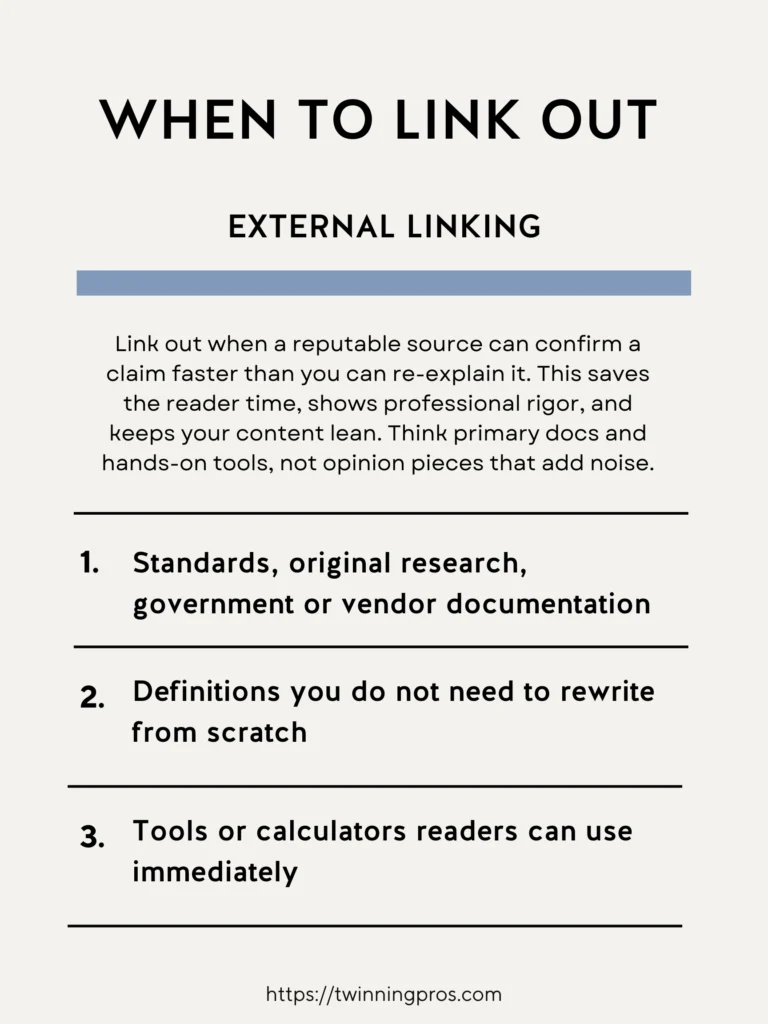
Anchor Text That Maintains Focus
The words you choose for your external links, known as anchor text, act like mini-headlines. They should clearly describe what’s on the other side while keeping the reader’s journey centered on your site.
For beginners, craft them to name the source and hint at the value without giving away your most important keywords, which you should save for internal links that strengthen your own content. This way, you’re not accidentally boosting someone else’s SEO at your expense.
Focus on phrasing that’s helpful and specific, ensuring the link feels like a natural extension of your sentence rather than a disruption, and always prioritize keeping your audience’s attention flowing back to your key messages and calls to action.
- Describe the source: “see Google’s documentation on sitemaps” – Sets expectations clearly.
- Avoid using your exact target keyword as the outbound anchor – Prevents diluting your own relevance.
- Reserve your best keyword variants for internal links – Builds your site’s internal strength.
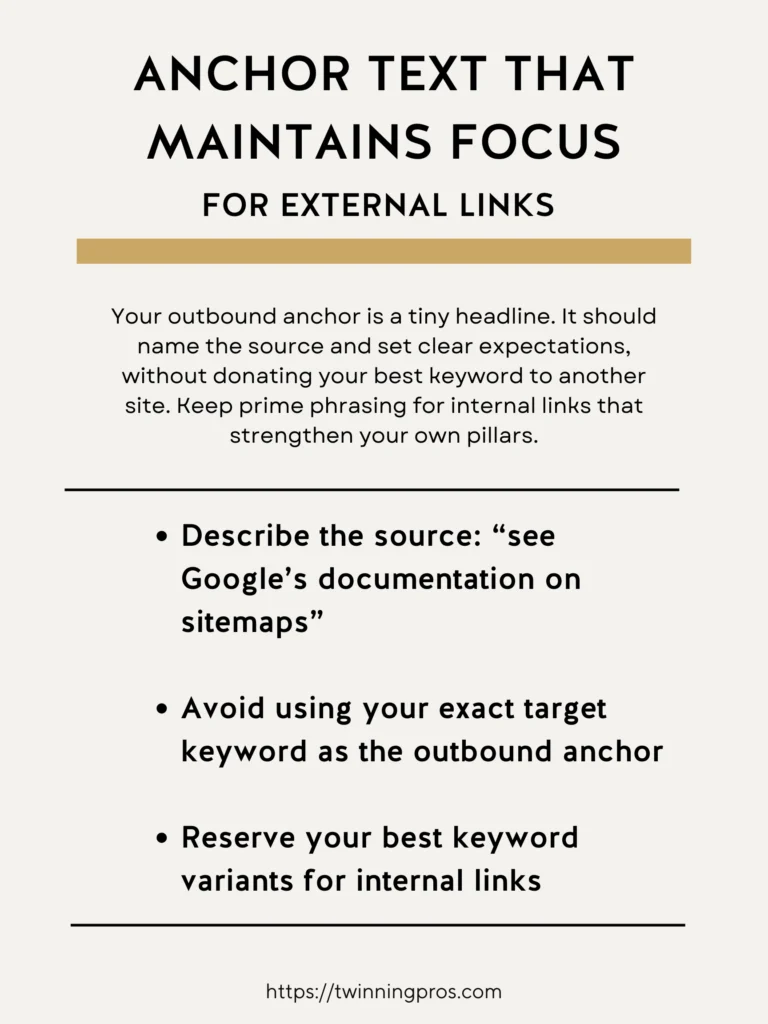
Balance and Formatting External Links
When it comes to how many external links to include and where to place them, less is often more. A handful of strong, relevant citations can build more trust than a long list of mediocre ones that overwhelm or distract.
For SEO beginners, position these links right next to the statements they support, so readers can verify immediately without scrolling to a bibliography at the bottom; this keeps the flow smooth and the credibility instant. Consider user experience too: on blog-style pages, have links open in the same tab to maintain continuity, but use attributes like rel=”sponsored” for paid promotions or rel=”ugc” for user-generated content to be transparent with search engines.
The goal is intentional linking that enhances your content without pulling focus away, ensuring your page remains the main attraction.
- A few strong sources beat many weak ones – Quality over quantity for impact.
- Cite near the claim instead of bunching all citations at the bottom – Makes verification easy.
- Open in the same tab for blog UX; use rel=”sponsored” or rel=”ugc” when appropriate – Balances flow and honesty.
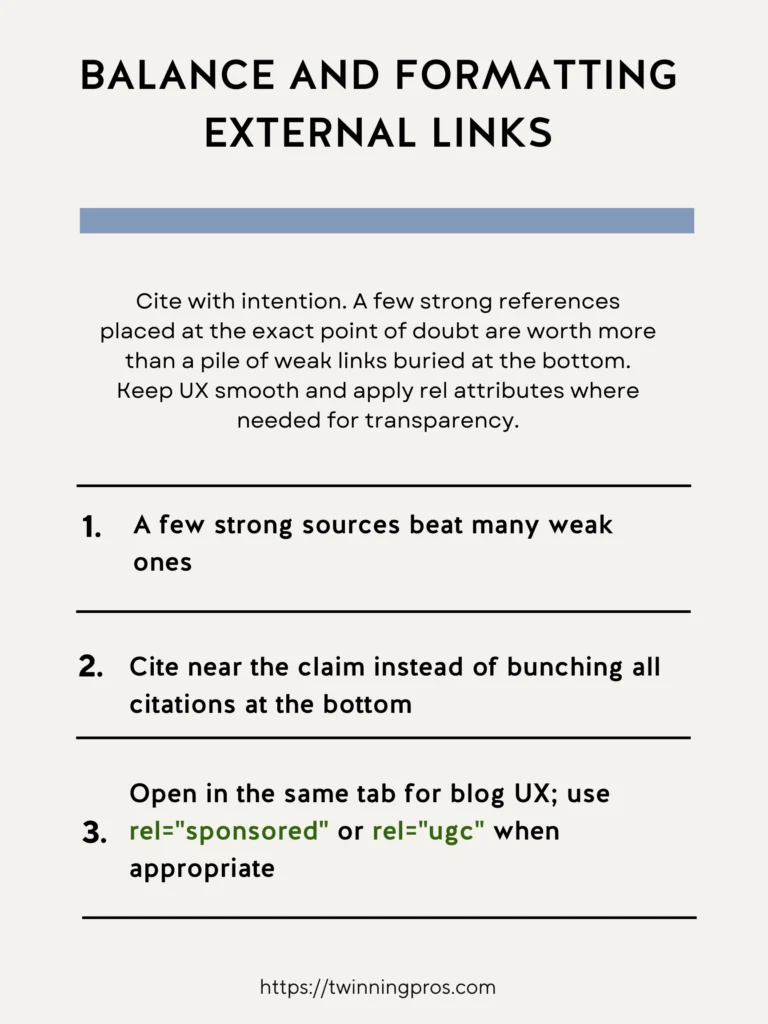
Don’t Create Exit Ramps From Money Pages
On pages designed to drive business, like those showcasing your products or services (often called “money pages”), external links should play a supporting role rather than stealing the show. Use them to bolster your arguments without tempting visitors to wander off.
For beginners, tuck these citations into sections like FAQs or explanatory side notes, where they address specific doubts without disrupting the main sales flow. Right after an external link, guide readers back with an internal one or a clear next step, like “Now that you’ve seen the official guidelines, check out our easy implementation checklist here.”
This keeps the momentum on your site, ensuring trust-building doesn’t come at the cost of conversions, and helps maintain your page’s focus on what you offer.
- Place external links in supporting sections – Keeps them helpful but secondary.
- Keep your primary CTA prominent and repeated – Reinforces your goals.
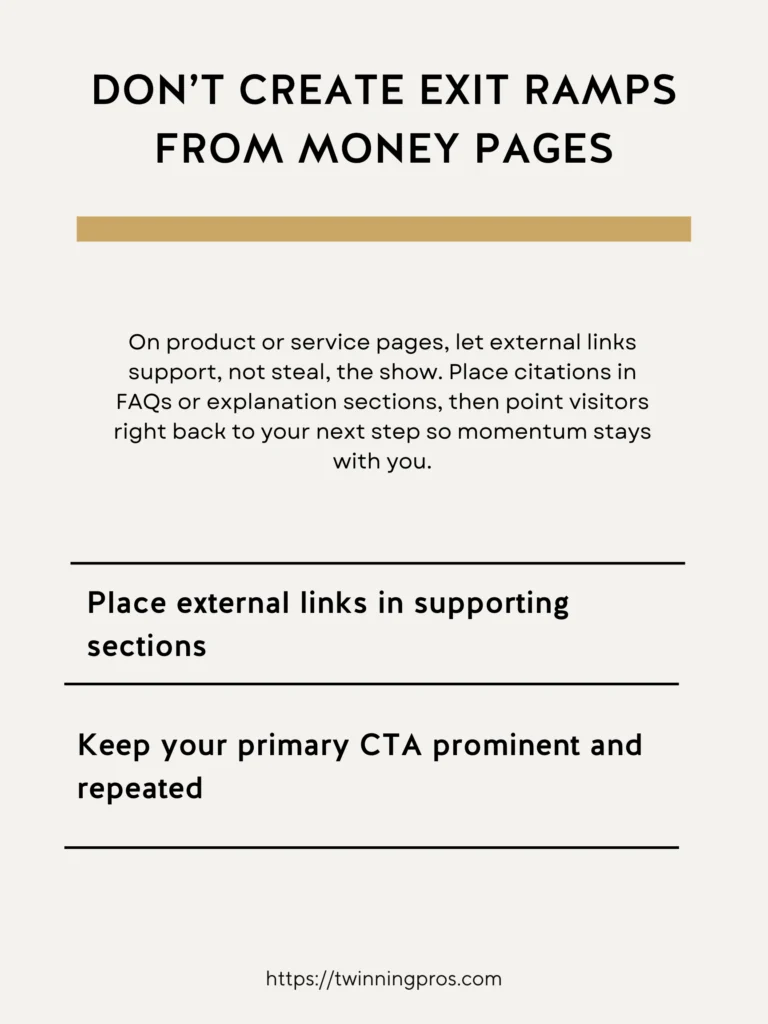
Quick External Link Checklist
Before hitting publish on a new page, take a quick moment to review your external links with this simple checklist. It’s an easy habit for SEO beginners to ensure they’re adding value without any downsides.
Confirm that your sources are reliable and directly tied to your claims, that anchors are descriptive but don’t use your top keywords, that you’ve used just enough citations placed strategically near the relevant text, and that there’s a smooth path leading back to your main content or call to action.
This fast check helps maintain high credibility while protecting your site’s focus and search performance, making your pages more effective overall.
- Reputable sources that directly support your claim – Ensures quality.
- Descriptive anchors that do not cannibalize target keywords – Protects your SEO.
- Minimal but meaningful citations placed near claims – Strategic for flow.
- Clear path back to your pillar and visible CTA – Retains attention.
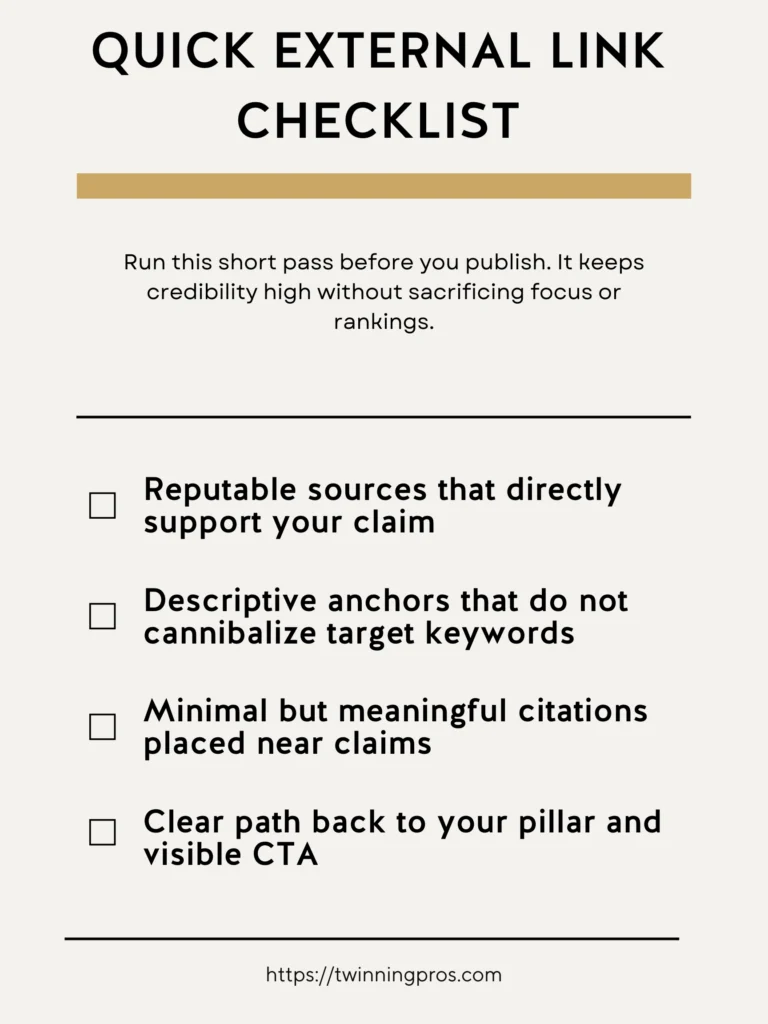
Final Thoughts
Credible sources remove doubt. Link to primary data, expert definitions, and original research near the claim. Then guide readers back to your solution with a clear internal link. Outbound links used well improve trust, help you earn mentions, and make your content a hub worth bookmarking.
Here is a simple playbook. Decide your source rules. Favor primary over secondary. Cite near the sentence that needs support. Use branded anchors. Open in a new tab. Pair every outbound link with a related internal link so the reader keeps moving toward your outcome.
Next Steps
As you’ve seen throughout this beginner’s guide to SEO fundamentals, small, consistent tweaks can make a massive difference in how search engines and visitors perceive your site. But remember, true success comes from a holistic approach tailored to your unique business. If you’re ready to take your SEO to the next level, check out our professional SEO services, where we handle everything from keyword research to on-page optimization to help you rank higher and attract more customers.
No matter where you are on your SEO journey, whether you’re just starting or already seeing some traction, it’s essential to have your website professionally audited at least twice a year to uncover hidden issues and keep things running smoothly; our comprehensive SEO Audit dives deep into your site’s performance, providing actionable insights without the overwhelm.
And if you want to build these skills yourself, enroll in our beginner-friendly course, The SEO CEO, I’m Tabatha, an SEO expert with years of hands-on experience, and after reviewing countless beginner courses that gloss over the details and lack real-world examples, I designed this in-depth program with plain-English lessons, step-by-step templates, and live walkthroughs so you can start applying these fixes today, not after wading through vague theory. Let’s turn your website into a traffic magnet; get started now and watch your online presence grow.
External Linking FAQs
Should I link out to other sites?
Yes. Google says external links can help establish trust when you cite sources. Link out when it adds context or proof, and tell readers what to expect at the destination.
Do outbound links boost rankings by themselves?
There is no special “outbound link boost.” The value is indirect. Clear citations improve usefulness and trust, which aligns with people-first guidance.
What should the anchor text say?
Use descriptive, human-readable anchors that name the source or the benefit. Example: “Google’s link best practices” instead of “click here.” Google’s docs call for descriptive link text.
When should I use rel sponsored, ugc, or nofollow?
Use rel="sponsored" for paid placements and affiliate style links.
Use rel="ugc" for links inside user generated content.
Use rel="nofollow" when you link but do not want to imply endorsement.
Google treats these as hints and recommends qualifying commercial links. You can combine values, such as rel="ugc nofollow".
Is nofollow still a directive?
No. Since 2019, Google treats nofollow, sponsored, and ugc as hints. Existing nofollows do not need to be changed, but Google recommends using sponsored for paid links going forward.
What counts as a link scheme I must avoid?
Buying or selling links that pass ranking credit, excessive link exchanges, automated link creation, and required links in contracts are all against Google’s spam policies. Qualify commercial links and avoid manipulative practices.
Should I nofollow every outbound link to be safe?
No. If you are citing a source naturally and there is no compensation, a normal followed link is fine. Overusing nofollow is unnecessary. Save sponsored or nofollow for paid or untrusted cases.
Do I need to disclose paid relationships in content?
Yes for users and compliance, and qualify those links with rel="sponsored" or rel="nofollow". Google has reminded site owners to correctly tag commercial links as part of link spam updates.
What is the right HTML for an outbound link?
Use a standard <a href="https://example.com">Descriptive anchor</a> with optional rel when needed. Make sure the link is crawlable and appears in the rendered HTML. Google emphasizes crawlable <a> links and descriptive anchors.
Do social, forum, or comment links need special handling?
Yes. Links created by users should usually be qualified with rel="ugc" and often nofollow. Moderate for spam and avoid turning UGC into an unvetted outbound link farm.
Can external links hurt my site?
Linking to spammy sites, selling followed links, or participating in schemes can lead to algorithmic devaluation or manual actions. Stick to reputable sources and qualify commercial links.
What is a quick external link checklist?
– Link when it improves clarity or adds proof
– Use descriptive anchors that set expectations
– Qualify paid or UGC links with the correct rel values
– Do not rely on nofollow to hide indexing issues
– Avoid manipulative exchanges or paid followed links
– These mirror Google’s link best practices and spam policy reminders.
What are some copy-ready patterns for external links?
Citation<a href="https://developers.google.com/search/docs/crawling-indexing/links-crawlable">Google link best practices</a>
Paid or affiliate style link<a href="https://partner.example.com" rel="sponsored">Partner offer details</a>
Comment link<a href="https://user-example.com" rel="ugc nofollow">user’s resource</a>
SEO for Beginners
Learn from the SEO Strategist who has 75+ first page Google rankings under her belt.
We’re marketing nerds and business strategists that have generated millions of dollars in client revenue. We're sharing the systems and strategies to help your growing business with marketing that actually converts.
We're Tiffany + Tabatha

Comments